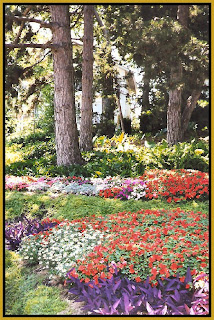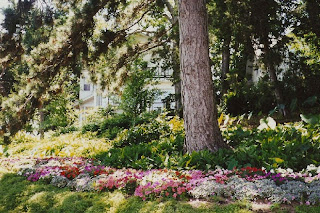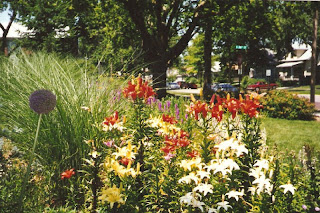 As many of you may know, I love to photograph both plants and flowers. So, an opportunity to visit the Sunken Gardens in Lincoln, Nebraska was one of the highlights to our trip there. Even though there are many tourist activities that would rate much higher on some other peoples' lists of things to see in Lincoln, Nebraska, this one rated about the highest with me. As you can see from these pictures, it was just a beautiful day and an ever prettier garden.
As many of you may know, I love to photograph both plants and flowers. So, an opportunity to visit the Sunken Gardens in Lincoln, Nebraska was one of the highlights to our trip there. Even though there are many tourist activities that would rate much higher on some other peoples' lists of things to see in Lincoln, Nebraska, this one rated about the highest with me. As you can see from these pictures, it was just a beautiful day and an ever prettier garden.The gardens themselves are at the southwest corner of 27th and D Streets, and have been the pride and joy of citizens since its completion in 1931. This 1.5 acre lot was constructed over the winter of 1930-31, during the worst financial depression the United States ever experienced. Well that may be a sign that it might be time for a new wing to this place given the current economic times and our own stock market woes, but this project was part of a program used by the City of Lincoln as an opportunity for unemployed men to earn money to support their families. The program helped families survive those hard times, as very little money was available for employment in any line of work.
In the early 1900s, Antelope Park extended from Sheridan Boulevard to O street, following the meandering path of the Antelope Creek. The construction of a new bridge over 27th street and Capital Parkway required straightening and relocating the stream several hundred feet to the north through D Street. Completion of the bridge left a large depression in the middle of the lot with a sheer bank on all sides, preventing development. As a result, for many years the area was used primarily during the winter by the neighboring children for sledding.
Incorporating the corner of 27th and D streets into an active part of the parks system had been a desire for many years. The piece of land that makes up the base of the Sunken Gardens was donated by Mr. Henry H. and Mrs. Sarah H. Frey in 1906. During this time, several lots in this area were donated to the Parks Department, adding to the linear nature of the park along Antelope Creek. In the fall of 1930, J.C. Seacrest donated two adjacent lots on the west side of the block to the Parks Department. The addition of these lots to the site provided the opportunity to create a garden of beauty for Lincoln's residents.
E.M. Bair, city commissioner and park head, (in those days) was the driving force behind the acquisition of this parcel of land and its development. Many newspaper articles credit Commissioner Bair as being one of the main government officials responsible for much of the development in the Parks Department. During this time, Bair created several different city improvements projects, of which he was able to assign temporary jobs to more than 200 unemployed men. This government sponsored program was put into effect to benefit the city and those in need Crew members were able to work an eight-hour shift at the rate of 40 cents per hour, twice per week, earning $6.40 per week. These temporary crews were sent out to work in many different areas of the parks to perform tasks ranging from tree trimming to construction projects. It was from this work force that at least 15 men were added to existing parks staff to help construct the Sunken Gardens.
In the beginning, the Sunken Gardens was referred to as Lincoln's "Rock Garden" to reflect its design. In fact when we first saw this place, we were somewhat surprised because we sort of thought that the gardens would have been under water rather that just under the street elevation from which it garners its name.
During the 1930s, in the United States, building rock gardens in progressive communities such as Lincoln was very popular. These gardens, including the Sunken Gardens, used rocks to form the garden's skeleton and contained rocks structures, such as water fountains or memorials. Rock retaining walls at different heights created terraced levels in the garden. Each level could be filled with different types of ground hugging sedum, a succulent perennial. Rock gardens were often located along and designed to mimic natural ravines using winding patterns and irregular widths. These design elements can still be seen in the rock walls of the Sunken Gardens.
Construction of the garden began with the removal of the old disfigured trees on the site. Then several truckloads of rock were brought to the site to lay out the rock walls. The rock used in the walls of the garden was harvested entirely from Lancaster County, of which Lincoln is the county seat. The cost of hauling the rock and the labor to install it were the only expenses for building the walls. The lower retaining walls were constructed of white limestone, while the reddish-colored rocks, which were collected from land south of where the Nebraska State Penitentiary currently stands, provided the main color scheme for the walls.
Semicircular flower beds were used to decorate the slopes along the north and east banks of the garden next to 27th and D streets. These beds were designed to accentuate the bright hues of the plantings on the bottom of the garden, contrasted by white gravel paths that wandered throughout the garden.
Three cement-lined pools were built in the bottom of the garden to create peaceful sights and sounds of water. The southern-most pool was used exclusively for a water lily display and contained several species of tropical and hardy water lilies. Henry Goebel reported that the majority of the lilies had been purchased from the Botanical Gardens in St. Louis, Missouri. The garden's main water display was the four-level waterfall, which flowed down the southern terraces. Water was pumped approximately 20 feet to the top and then trickled down four large steps into a pool stocked with colorful fish.
"I expect to make this spot the most beautiful place in the city, either in or out of the parks. The ground lends itself perfectly to the making of a sunken garden, and at the same time a spot rich in beauty, at a small expense." ~ E.M. Bair, Lincoln NE city commissioner and park head during the years of the Great Depression























